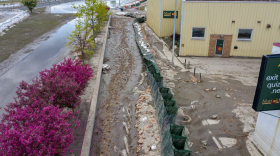Hundreds of communities line the Mississippi River on its 2,348-mile journey to the Gulf of Mexico, but Davenport, Iowa, stands out for the simple reason that people there can actually dip their toes in the river without scaling a flood wall, levee or other impediment.
It's a point of pride in Davenport, a city of 100,000 people that calls itself Iowa's front porch and which has repeatedly tolerated the floods that have long since convinced all other major riverfront cities to build concrete or dirt walls.
"It's the personality of the community," said Kelli Grubbs, who runs a business a few blocks from the nearly half-mile-wide river. "There is just a great love of the river."
That love is being tested this summer after record-setting floods broke through temporary barriers and for weeks inundated some of Davenport's trendiest restaurants and shops with foul-smelling water.
Now that the river has finally seeped back to its banks, business owners and city officials are confronting a painful question: Can they still remain connected with the river without being overwhelmed by it?
It's not so simple as, 'Let's go build a wall.' Our riverfront is one of the major attributes of our community. We want to be able to maintain that and embrace the Mississippi River.
Looming over the discussions is an acknowledgement of what's likely coming from climate change: heavier rainstorms that, combined with spring snowmelt, will swell the river to ever higher levels.
Davenport is one of the many communities across the nation struggling with their past assumptions about the weather.
Even as residents scoff at the prospect of a concrete wall or rocky levee replacing the gently sloping lawn that dips down to the river, they wonder if a downtown that has seen roughly $500 million in investment in recent years can survive being awash and cut off from the rest of the city so frequently.

This spring a key road was closed for 100 days and fans couldn't reach the riverside minor league baseball stadium.
A popular brewery credited with spurring a downtown revival is still closed because its equipment was submerged.
Of the 15 biggest floods in Davenport's history, seven have occurred since 2008.
"Obviously, the weather is not getting any better," said Kyle Carter, executive director of the Downtown Davenport Partnership, a business group. "Regardless of why you think it's happening, it's happening."
Davenport owes much of its roughly 200-year-old history to the Mississippi River, which was instrumental in the area's selection as a fort. The river allowed steamboats to reach the community and later led to bridges that connected people and products to large cities to the east.

That history is one reason that despite repeated flooding in the last 40 years — especially severe in 1969, 1975, 1993 and 2001 — Davenport residents have largely supported a modest containment system that includes a wide strip of grass and Nahant Marsh, a 305-acre wetland.
During more serious flooding, large sand-filled temporary barriers can be placed on River Drive, which runs parallel to the river, to protect the low-lying business district. Most homes are safely perched on the hills rising steeply to the north.
But this spring, separate crests repeatedly pressured and finally breached the barriers, causing an estimated $30 million in lost revenue and damage.
"For a week or two, people were boating down the street," said Grubbs, who rushed to save expensive equipment in her virtual reality gaming business when water began surging inside.
Davenport residents also couldn't help but notice that across the river in Rock Island, Illinois — where a permanent floodwall was erected after floods in 1993 — the city stayed almost completely dry. Bettendorf and Moline, Illinois, the other two communities that make up the Quad Cities, also have floodwalls and didn't flood.
Mayor Frank Klipsch has formed a task force to consider options, which include setting aside more land that could be open for flooding and improving the system of temporary barriers protecting the city's nine miles of riverfront.
"It's not so simple as, 'Let's go build a wall.' " Klipsch said. "Our riverfront is one of the major attributes of our community. We want to be able to maintain that and embrace the Mississippi River."
One factor is the $175 million or higher cost of a flood wall that would have to be mostly locally funded. But another is that an expanded buffer would be less reliable and require a lot of property.
Environmentalists support giving the river more room instead of a wall, but the pragmatic concerns weigh heavy.

"We saw water go where water has never gone before, so it really shook the community and it awakened all of us to say, 'What are we doing? Is this a new reality for us?' " said Paul Rumler, the leader of the Quad Cities Chamber of Commerce.

Becca Clark said she supports the city's go-slow approach, even though the flooding forced workers and customers to frantically haul items up a narrow staircase to the second floor of her clothing and jewelry shop.
"The city is all about the natural flow of the river and green space. It would ruin that," said Clark, who grew up in the area.
But, as they settled into a new location a block farther from the river, her business partner Nicole Perez noted, "We fixed our problem. We moved up higher from the river."
To see The A.P. photos for this story, click HERE.
Beck reported from Omaha, Nebraska.
Follow Scott McFetridge on Twitter: https://twitter.com/smcfetridge Follow Margery A. Beck on Twitter: https://twitter.com/margery3



